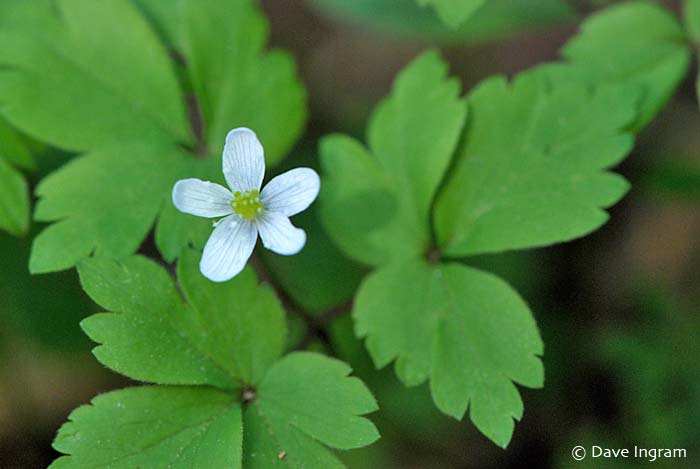
One of the spring wildflowers to look for in the coastal forests of Vancouver Island at this time of year is Lyall’s Anemone (Anemone lyallii). If you’re walking quickly it is easy to miss this beautiful little plant. The flowers are small and very easily missed.
A Member of the Buttercup Family
Lyall’s Anemone is a member of Ranunculaceae (Buttercup family) and typically found in moist meadows and forests. I’ve found several different patches of this plant on the Wildwood Trail in Courtenay (Burns Road access) and in Miracle Beach Provincial Park along the trail that runs beside Black Creek.

Identifying Lyall’s Anemone
The coarsely toothed leaves of this anemone form groups of three. They are palmately compound with three lobes giving the plant a delicate look. The single flower on each plant is quite small, between 12 to 20mm wide, and ranges in colour from white to pale blue, to pinkish. The flower has no petals but does have 5 petal-like sepals.

Named in Honour of David Lyall
The name of this delicate woodland wildflower references Dr. David Lyall (1817-1895). Among other accomplishments, J.D. Hooker writes in Lyall’s obituary that:
Dr. Lyall was commissioned as Surgeon and Naturalist to H.M.’s surveying ship ‘Plumper’ and afterwards to the ‘Hecate’, under Captain (now Admiral Sir George) Richards, employed in the delimitation of the sea boundary between Great Britain and the United States in the Pacific Ocean. From this his services (in 1858) were transferred to the Land Boundary Commission, under Col. Sir John Hawkins, R.E., which he accompanied in its survey of the boundary line between British Columbia and the United States possessions, from the Gulf of Georgia to the summit of the Rocky Mountains. From this exploration Dr. Lyall brought home a magnificent herbarium, one of such importance that, at the earnest representation of Sir William Hooker, he was borne on the books of H.M.S. ‘Fisguard’ at Woolwich as Staff Surgeon, a vicarious appointment that allowed of his residing at Kew for the purpose of arranging, reporting on, and distributing his collections.
Journal of Botany, 33: 209-211. 1895.
Lyall’s Anemone is mentioned briefly in Plants of Coastal British Columbia, but those interested in a detailed description of the plant and additional images should consult the llustrated Flora of British Columbia or eFlora. A short history of Dr. David Lyall is on Explorers Garden: The Scottish Plant Hunters Garden.
Look for this delicate anemone the next time you walk along a stream side trail on Vancouver Island!